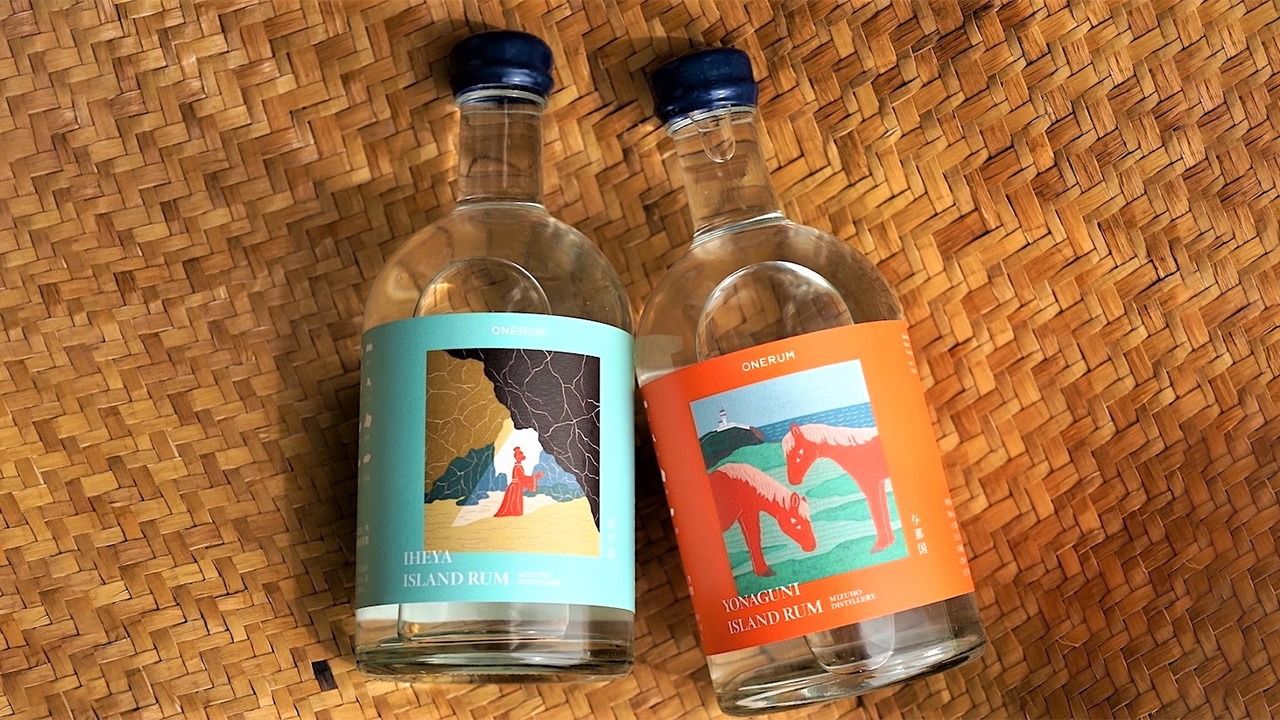
The Distiller Aiming to Make Okinawa a Major Rum Producer
Food and Drink Economy- English
- 日本語
- 简体字
- 繁體字
- Français
- Español
- العربية
- Русский
New Rums from Japan’s Subtropical South
This year is a landmark date in the modern history of Okinawa, marking 50 years since the islands reverted to Japanese sovereignty after World War II. Media interest in the islands is higher than it has been for years. Even the latest NHK morning drama, Chimu dondon (an Okinawan phrase meaning something like “a heart beating with excitement”), which started on April 11, is set in the southernmost prefecture.
This is not the first time NHK has set its popular morning drama in the islands. Churasan (Pure Beauty), broadcast in 2001, is often credited with having sparked the “Okinawa boom” that marked a highpoint of public enthusiasm for all things Okinawa during the early years of the new millennium. Among the beneficiaries of this popularity was Okinawa’s native spirit, awamori, which is distilled from imported Thai rice and serves as a potent reminder of the region’s historical ties with Southeast Asia. Sales of awamori surged during this period, with shipments hitting a historic high in 2004. Unfortunately, the popularity proved short-lived. The drink’s sales have plummeted in the years since, and even locals now drink much less of the stuff than they once did. Sales have dwindled year after year, and shipment figures in 2020 were less than half what they were in 2004.
Despite these inauspicious circumstances, one producer in Okinawa is determined to see these difficulties as an opportunity, and has recently launched a new project that promises to open up a new future for distillation in the prefecture.
The One Rum project is the brainchild of Mizuho Shuzō, an awamori distillery located in Shuri, formerly the royal capital of the Ryūkyū Kingdom (1429–1879) and now part of the prefectural capital of Naha. The project will produce a range of eight small-batch rums distilled from brown sugar produced on eight islands in the prefecture: Yonaguni, Iriomote, Hateruma, Kohama, Tarama, Aguni, Ie, and Iheya. The islands have long been the top sugar-producing area of the nation, but today much of the sugar they produce languishes unsold in warehouses. The ultimate vision behind the project is to turn Okinawa into a major center of global production, rivaling the famous rum islands of the Caribbean.
I recently visited the distillery to learn more about the project from Nakazato Akira, head of R&D at Mizuho Shuzō. Nakazato’s professional experience is not limited to the traditional awamori that is his company’s speciality, having previously worked on a variety of new products including an awamori-based gin and bitters that won considerable international acclaim. In the world of craft distilling, Nakazato has a reputation as a master innovator. Nakazato was waiting for me under the trademark “heavenly dragons” that adorn the entrance to the company’s Tenryū-kura warehouse, wearing an olive-green T-shirt bearing the legend: “Frontier Spirits.”
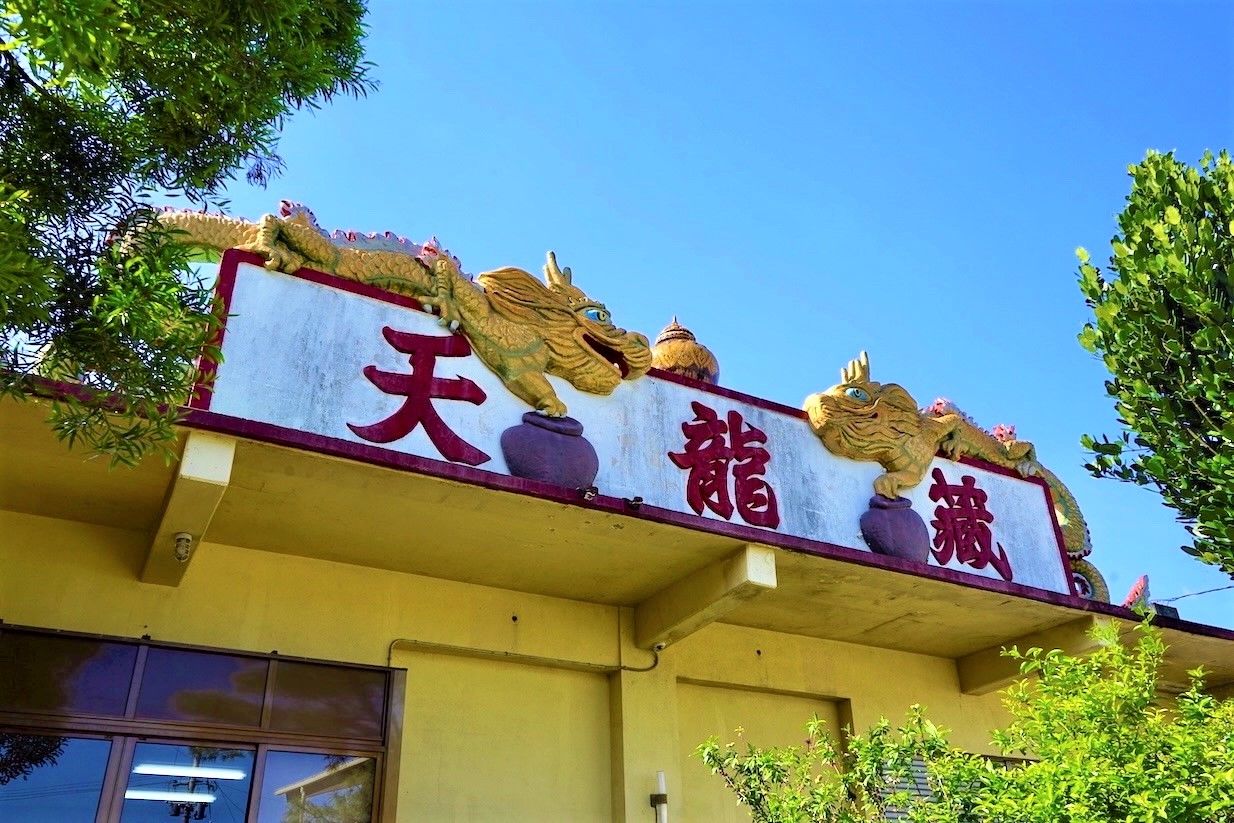
Dragons decorate the Tenryū-kura, literally the “storehouse of heavenly dragons,” at Mizuho Shuzō, Shuri’s oldest distillery. (© Ukita Yasuyuki)
“This project is built on the same ‘frontier spirit’ that lies behind everything we do,” he explains. Mizuho Shuzō is one of only a handful of surviving distilleries that provide a link with Okinawa’s past as an independent kingdom. It was founded in 1848 in Torihori, one of three districts in Shuri that were licensed to produce awamori under the direct jurisdiction of the royal government. It is the second-oldest producer of awamori in Okinawa Prefecture today. But its impressive history is not the only thing that makes the distillery remarkable.
During World War II, the distillery moved into Burma to produce awamori for the military. In 1970, it constructed the large Tenryū-kura warehouse and became one of the first distilleries to return to producing and selling aged awamori (kūsu in the local pronunciation), which had become unusual in the industry. In 1998, the company built a distillery in Taiwan, where it produces OEM brands of whisky and wine.
“Throughout our history, we have always adapted to changing circumstances. Our aim is to use our skills in distilling in a way that matches the needs of the times. This attitude is an essential part of our identity.”
Falling Demand, Increasing Production
So why rum, and why now? To answer this, Nakazato begins with an account of the difficulties facing sugarcane production in Okinawa today.
Sugarcane is produced throughout Okinawa Prefecture. In fact, it is by far the biggest crop on the islands in terms of acreage of land under cultivation, far ahead of other crops like pineapples and purple sweet potatoes. Most of the cane grown on the main island of Okinawa itself is processed into white sugar. The cane grown on the smaller islands, by contrast, is sent to factories on each island, where it becomes the less heavily refined, more characterful brown sugar. Since the 1990s, health concerns, a growing preoccupation with dieting and weight loss, and the spread of artificial sweeteners have combined to send demand for sugar plummeting. To a certain extent, sales have been propped up by the tourist industry, where brown sugar is a favorite souvenir of a trip to the islands. But the COVID-19 pandemic has had a destructive impact on the tourist trade and effectively reduced that demand to zero.
Despite dwindling demand for the end product, the national government subsidizes sugarcane in the islands, and is even looking to increase production. The idea is that by supporting the cultivation and processing of sugarcane, the subsidy program creates jobs on the islands and persuades the population to stay there rather than moving elsewhere in search of employment. A look at the map makes the strategic reasons for this clear: islands like Yonaguni and Hateruma mark the southernmost extreme of Japan’s inhabited territory, making them vital in terms of defending the nation’s borders.
Of course, the natural consequence of increasing production when demand is falling is that a lot of the sugar produced ends up unsold. Several thousand tons of brown sugar are added to warehouse stockpiles every year. Some of this excess goes to animal feed. And during the pandemic, molasses produced from this sugar has been used to make alcohol for hand sanitizer and disinfectants. Molasses is a by-product of the sugar refining process, and is the raw material from which most of the world’s rums are made. But producing unmarketable sugar to obtain the by-product of molasses makes little economic sense and turns the traditional model of sugar production on its head.
As Nakazato’s reputation as an innovative distiller spread, he found himself approached by a number of companies looking for a partner in new rum-distilling projects. Although the demand for sugar has been on a downward spiral for decades now, demand for rum has recently been increasing worldwide. According to a survey carried out by the American market research firm Grand View Research, the global market for craft rum is expected to grow by an annual average of 5.2% between 2020 and 2027, driven by an increasing interest among young consumers for quality alcohol products with a persuasive narrative of “authenticity” behind them.
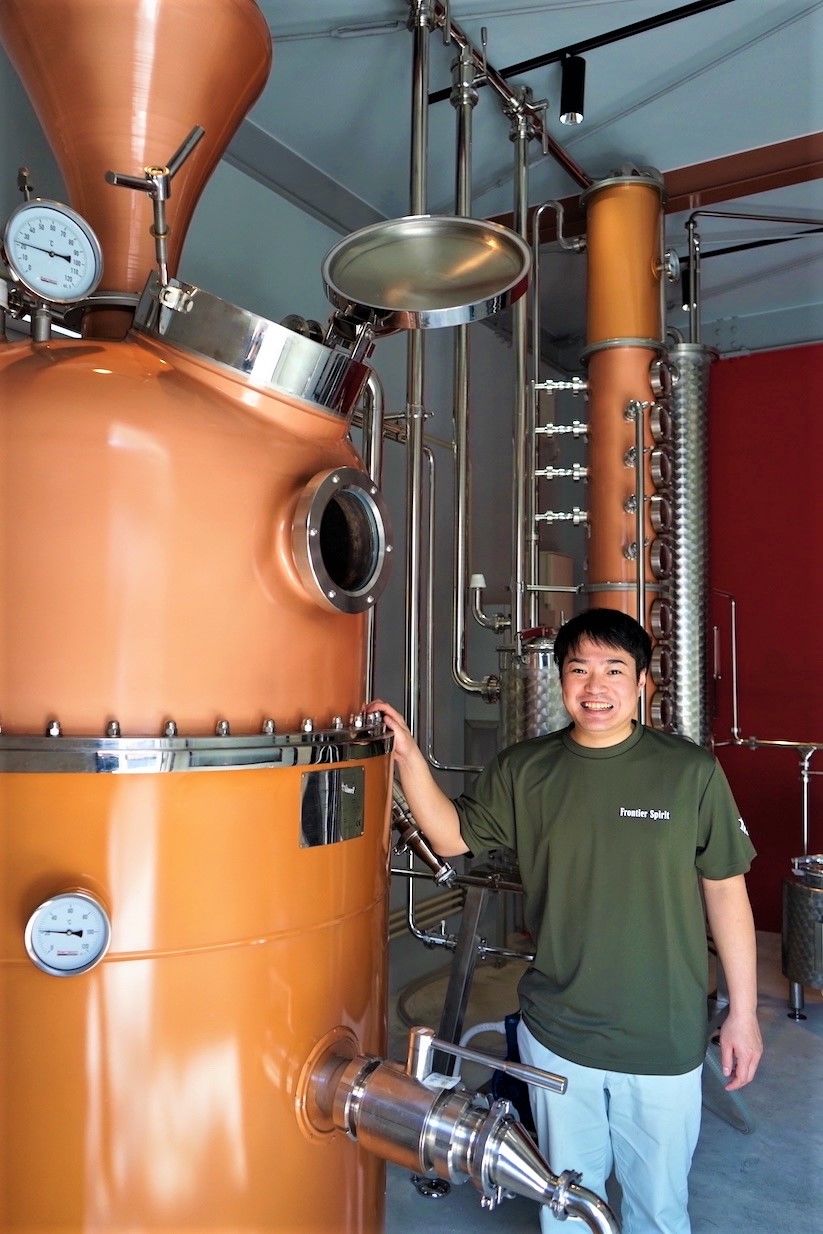
Nakazato Akira is renowned for his talent in creating rums and gins, in addition to his distillery’s staple awamori. (© Ukita Yasuyuki)
After receiving offers from around a dozen companies, including some from overseas, Nakazato decided to think seriously about the prospects for rum in the islands. The One Rum project was launched in November 2020.
“We thought the demand for molasses was likely to continue for some time, so we decided not to touch that, and we started by trying to see if we could use our expertise and technology to do something with the huge stocks of brown sugar currently going to waste in the islands,” Nakazato explains. As mentioned above, most rum is produced from molasses, which was originally a waste product of the refining process. This type of rum, which makes up the bulk of global production, is known as “industrial rum.” Another type of rum is made directly by fermenting and then distilling sugarcane juice squeezed from the sugarcane. This type of rum, produced especially in the Francophone islands of the Caribbean, is known as “agricultural rum,” or rhum agricrole. The scarcity and character of these rums makes them much sought out by connoisseurs. The technique adopted by One Rum, which uses brown sugar dissolved in water as the raw material for its rum (categorized as a type of “industrial rum,”) is a rare approach found hardly anywhere else in the world.
Island Terroir
In fact, what is often referred to sweepingly as “brown sugar” varies considerably in flavor depending on where it is produced. The sugar from Iheya Island, for example, is often said have a “clean” taste, while sugar from Hateruma has an earthier, more complex flavor. Each island has its own unique flavors. This variety, which comes from the different cultivars of cane grown as well as differences in production methods, climate and soil, naturally results in different flavors in the rums made from Okinawan sugarcane. In today’s premium beverage market, where “terroir” has become a prized quality crucial to the value of the distinctive wines and coffees produced in different parts of the world, this variety of flavors promises to be a major selling point for marketing Okinawan rum.
Rum was first released from two of the eight islands: Iheya and Yonaguni. The first batch of 800 bottles sold out almost immediately. Rum from a third island (Hateruma) arrived at the end of April. On my visit to the distillery, I was treated to a tasting of the first two expressions on the market, both unaged “white” rums.
The Iheya rum I found, offers sweetness and elegance on the nose, with a soft, delicate aroma more reminiscent of refined white sugar than raw brown sugar. On the palate, it is an easy-drinking tipple, with notes of Japanese citrus and lichee.
The Yonaguni rum, meanwhile, is noticeably heavier and more complex on the nose, with a somewhat funky, ester-rich, iodine tang. Overall, I found it drier in feel than the Iheya product.
Although both rums can be enjoyed straight, I felt both offered great potential for use in cocktails. The distillery is already experimenting with aging some of the raw spirit in used oak barrels bought from a well-known Japanese whisky distillery. Hopes are high for the aged spirits in a few years’ time. Rums from all eight islands should be on the market by the end of next year. The timing could hardly be better: 2023 marks 400 years since the local ruler Gima Shinjō (1557–1644) sent a young envoy from the Ryūkyū Kingdom to China to study the technology of sugar refining and bring it back to Okinawa.
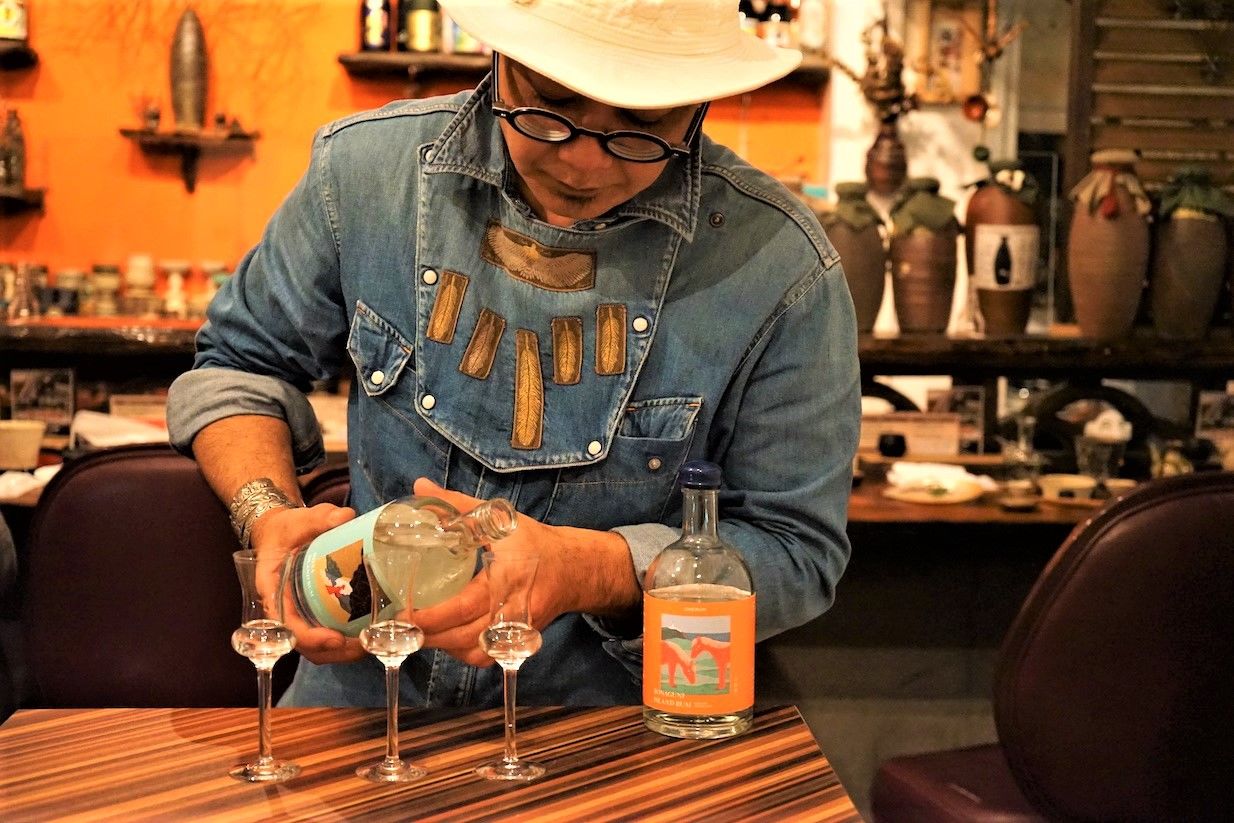
Oninoude, a bar in the city of Naha frequented by Okinawa’s top awamori artisans, is one place to sample Nakazato’s rum creations. (© Ukita Yasuyuki)
The Future of Distilling in Okinawa
But there is more to the One Rum project than this. Nakazato explains what might be described as the flip side:
“Talking to the local producers on the islands, I came to realize there was still too much we didn’t understand about sugarcane production. We decided to take on the challenge of growing cane ourselves, with our own hands.”
The project involved participation from a diverse range of supporters and advisors, including JA Okinawa, the Okinawa Prefectural Brown Sugar Industry Association, the Okinawa Regional Taxation Office, the University of the Ryūkyūs, local cultivators interested in environmentally sustainable farming methods, directors from the hospitality industry, and bartenders. Nakazato received help and cooperation from all sides, from introductions to potential sites for the fields to tips on how to cultivate the cane. The company plans to use its own sugarcane for a rhum agricole that will be branded separately from the single-origin rum produced from brown sugar grown on the eight smaller islands.
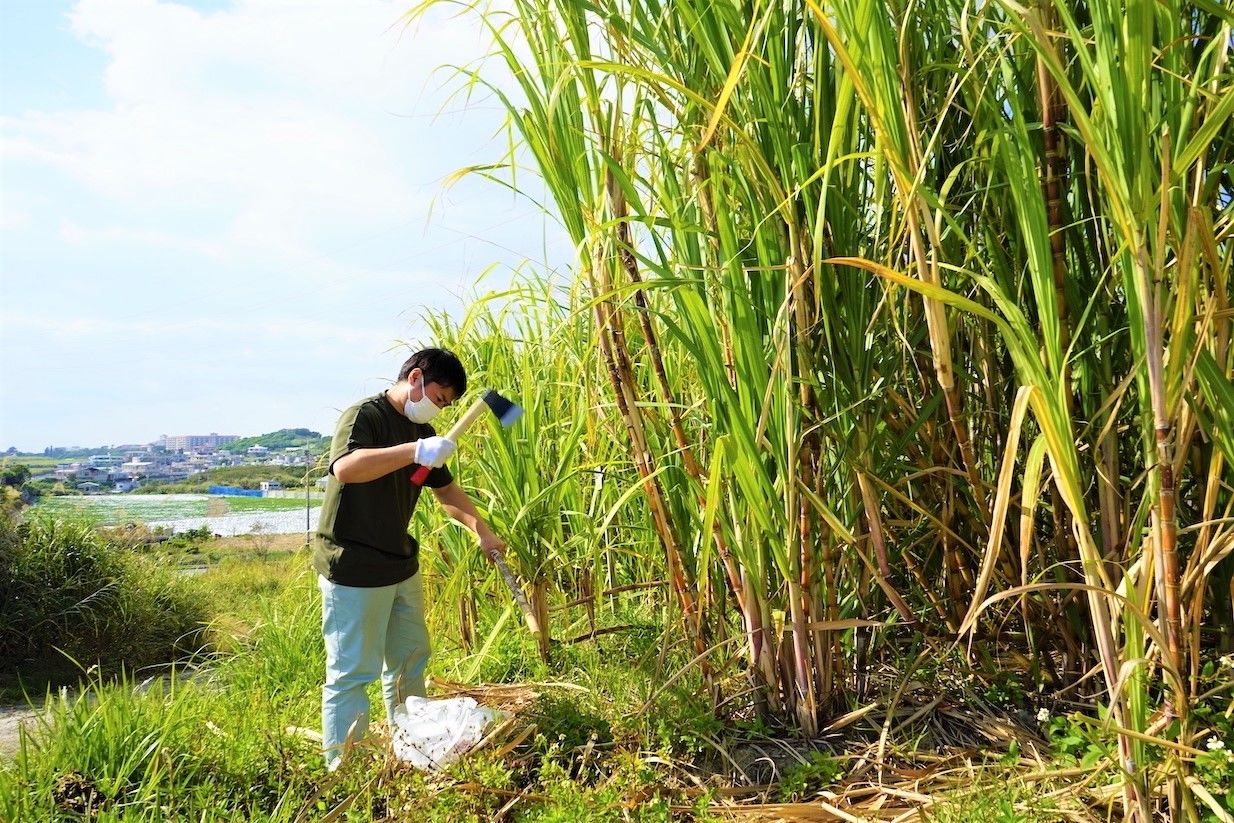
Nakazato takes a hatchet to a stand of sugarcane. He is currently researching ways to obtain the yeast needed for brewing from the cane itself. (© Ukita Yasuyuki)
Nakazato took me out to the company’s cane fields outside the city of Itoman. At the end of a dirt track shaded by lush banana leaves stretched fields full of ripe sugarcane ready for harvesting, easily twice the height of an adult human. (Despite the impressive appearance of this crop, I am told that each stalk only yields around the equivalent of a tablespoon of sugar once refined.) A sudden gust of wind sent up a dry rustling sound as the cane shook and swayed, reminding me of “Zawawa” by Moriyama Ryōko, a song about the melancholy rustling sounds of fields full of Okinawan sugarcane, whose antiwar message made it a popular hit in the early seventies around the time of Okinawa’s reversion to Japanese sovereignty.
“We grow three different varieties of cane. Everything is planted and harvested by hand.” As he speaks, Nakazato slowly removes a small hatchet from the trunk of his car. “I’m just going to take a sample for analysis,” he says, neatly cutting away a section of the cane as thick as a baseball bat, with the practiced skill of a farmer who’s been chopping cane for years.
The past couple of decades have not been easy for awamori. But Okinawa’s distilling expertise, honed over the centuries, is very much alive and well. Nakazato’s ambitious new undertaking aims to change the way people think of sugarcane and brown sugar, giving it new value and helping to build a better future for the industry. Okinawa has long been known to spirits aficionados as the home of awamori. My visit made me hopeful that this new project might transform the prefecture into something much more, and help to put Okinawa on the map as a “spirits island” of a new kind.
(Originally published in Japanese on April 15, 2022. Banner photo: From left, the Iheya and Yonaguni rums produced as the first two releases in the One Rum project. The labels show illustrations of local sites associated with the two islands: the Amano-Iwato [Heaven’s rock] cave legend for Iheya and Yonaguni horses [a designated natural monument] for Yonaguni. © Ukita Yasuyuki.)